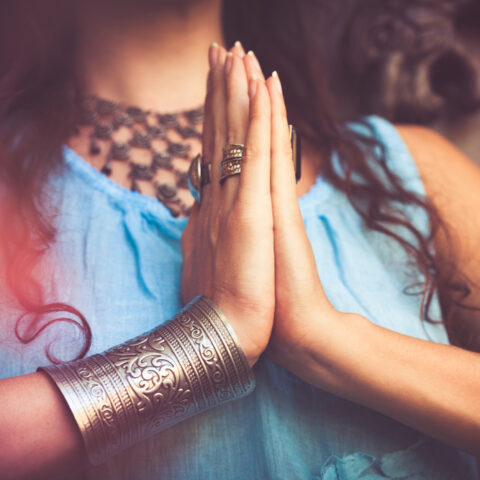Most people probably think of yoga as a physical exercise that forces participants to twist themselves into human pretzels. While that is one aspect of yoga, the history of this practice goes much deeper.
In fact, yoga is thousands of years old and its origins may surprise individuals who are only familiar with its physical applications in the Western world.
When Was Yoga Invented? The Origins of Yoga
In actuality, the exact origins of this ancient practice are unknown but we do know that yoga has been practiced for over 5,000 years.
Some historians say that yoga may be up to 10,000 years old but since it was first passed down via oral tradition, its exact beginnings remain obscured.
What we do know is that yoga is mentioned in the ancient Vedic texts, sacred writings that included rituals, songs, mantras, and more. These texts can be traced back to the Indus-Sarasvati civilization in the north of India.
The first written mention of the word yoga is in the Rig Veda, where it is interpreted to mean yoke or yogically controlled.
That being said, the Rig Veda does not reference the practices of yoga, although the subject is described more in the Brihadaranyaka Upanishad about 700 years later in 700 BCE.
This sacred text refers to the yogic breathing technique of pranayama as well as pratyahara, or the withdrawal of the senses. Another ancient text that is crucial to yoga is the Bhagavad Gita, which was written around 500 BCE.
Translated from Sanskrit to mean “The Song of God,” this book touches on the concepts of Brahman (the Absolutely Reality) and dharma (one’s karmic duty), elements that are important in yoga.
It was around this time that specific groups began to adopt yogic practices. For example, early Buddhism and Jainism employed psychophysical techniques and ascetic practices, some of which were later described in yogic circles.
That being said, these practices were borrowed from the Vedic tradition and included meditation and the mastery of the body and senses.
This was a time of mix-and-match yoga, so to speak. The ancient Vedic tradition was present but so was a Buddhist take on the practices and there was the introduction of Jain yoga, a meditative spirituality in the Jain religion.
The Emergence of Classical Yoga
Between the period of 200 BCE and 500 CE, the different “schools” of yoga began to break off into their own systems.
The primary schools of yoga at this time belonged to Buddhism, Jainism, and Hinduism, which began to develop around this time. As is prevalent among classical periods, this time period introduced several important texts that introduced the crucial components of yoga.
One of the key texts during this era was the Yoga Sutras of Patanjali, which many historians credit as the first written system explaining what yoga is and how to practice it.
The Yoga Sutras are concerned with Classical Yoga, also known as Raja Yoga, which features the eight-limbed path that some yogis recognize. These eight “limbs” are crucial steps that one must take in order to reach enlightenment or one with the Divine.
While different styles of yoga developed over the years, many branches of yoga continue to use Patanjali’s Sutras as a basis.
New Schools of Yoga
Between 500 and 1500 CE, several branches of yoga emerged. While they each maintained a similar overarching theme to Raja Yoga, they differed in techniques and practices.
Bhakti yoga began in southern India between the 6th and 9th centuries and is focused on loving devotion to a personal god.
It borrowed some practices from the Yoga Sutras of Patanjali, predominantly meditation. Chapter 7 of the Bhagavad Gita mentions Bhakti Yoga. In this branch of yoga, practitioners practice mindful devotion to the god or goddess of their choice.
Jnana Yoga is concerned with the path of knowledge and is mentioned in the Bhagavad Gita as well as a means to achieving liberation.
Jnana Yoga includes meditative practices to help one realize his or her ultimate Self and relationship to Brahman, or the Absolute. This tradition is referred to in the Upanishads as well.
The third branch of yoga that is referred to in the Bhagavad Gita is Karma Yoga or the “yoga of action.” Karma Yoga focuses on selflessness and acting in accordance with one’s dharma, or Divine duty.
The Bhagavad Gita refers to Karma Yoga as a means of purifying the mind. The idea is that selfless action and living according to one’s dharma helps a person realize his or her likeness to the Absolute or, in other words, liberation.
The Brihadaranyaka Upanishad alludes to karmic action, although it does not name Karma Yoga specifically.
Hatha Yoga came about during the 10th century or so and is attributed to Matsyendranath, a yogi who practiced in both the Buddhist and Hindu traditions.
Early Hatha Yoga was concerned with spiritual abilities such as levitation and liberation. Practices included bodily postures (asanas) and breath control to regulate one’s vital energy.
Hatha Yoga also delved into clearing the chakras, awakening the divine Kundalini spirit, and controlling the flow of bodily fluids.
The earliest Hatha Yoga texts still borrowed from the Vedic tradition and its focus on non-duality is attributed to its growth around India.
Modern Yoga
In more modern times, the practice of yoga has evolved even more. One example of this is Kriya Yoga, or “yoga of action,” which was founded by Mahavatar Babaji and his disciple Lahiri Mahasaya around the early 1860s.
This school of yoga has its origins in the Yoga Sutras of Patanjali, particularly the techniques of pranayama (breath control), mantras and mudras, or symbolic gestures.
The 1946 book Autobiography of a Yogi by Paramahansa Yogananda, recounts Lahiri’s initiation into Kriya Yoga, which is likened to the god Krishna’s blessing upon Arjuna in the Bhagavad Gita.
The 20th century also brought a reemergence of Hatha Yoga, this time in the Western world as a form of exercise that helps practitioners achieve a deeper physical-spiritual connection.
While Swami Vivekananda is credited as the first person to bring yoga to the West in 1893, many others followed in his path throughout the years. Philosophers of the time took to yoga’s teachings and the idea of universalism.
When Indra Devi opened a yoga studio in Hollywood in the 1940s, yoga as a form of exercise really took off. People were drawn to the physicality of the asanas as well as the relaxing effect of the pranayama breathing techniques.
B.K.S. Iyengar’s yoga as an exercise approach and Bikram Choudhury’s hot yoga arrived in subsequent years as well.
Today, most people who practice yoga in the West are practicing a form of Hatha yoga, focusing primarily on asanas (postures) and breathing techniques.
So, Who Actually Invented Yoga?
No one knows for sure who invented yoga or when yoga first appeared in India.
What historians do know is that the practices that have characterized yoga throughout the centuries were first attributed to the ascetic movement in India around the 5th century BCE.
The invention of yoga is not credited to one person, although there are key figures throughout history who influenced the practices and branches of yoga that we see today.
We first see the mention of yoga in the Rig Veda, which dates back to 1500 to 1200 BCE in northern India’s Indus-Sarasvati civilization. The sacred Rig Veda was most likely written by more than one person and it may have been oral tradition centuries before it was transcribed in writing.
Over hundreds of years, seers, priests, and other spiritual leaders studied sacred texts such as the Rig Veda and documented their own approaches and beliefs in the Upanishads, introducing a more concrete idea of self-knowledge, karmic action, and meditation.
Different people took their own approach to yoga as time went on, giving us the Yoga Sutras of Patanjali and other central yogic ideas. It’s clear that there isn’t one particular founder of yoga and it seems that this practice evolved naturally over time.
Of course, there were different branches that emerged over history and some of them do have historical beginnings and founders.
For example, Hatha Yoga is attributed to Matsyendranath in the 10th century and Kriya Yoga was founded by Mahavatar Babaji and his disciple Lahiri Mahasaya in the 1860s. B.K.S. Iyengar created his own approach to yoga (Iyengar Yoga) in the 1960s and focused primarily on exercise.
Bikram Choudhury created Bikram yoga, or hot yoga, from the Hatha yoga tradition in the 1970s.
Therefore, the short answer is that we don’t know who invented yoga. Yoga is so much more than sitting cross-legged and chanting “om” or doing downward dogs in a hot room.
It’s a spiritual tradition that dates back over 5000 years on the Indian subcontinent. It is rooted in numerous ancient and sacred texts that don’t even have a clear origin.
Perhaps the question of who invented yoga is less important than the question of how to properly practice it; even then, there are various approaches to take.

